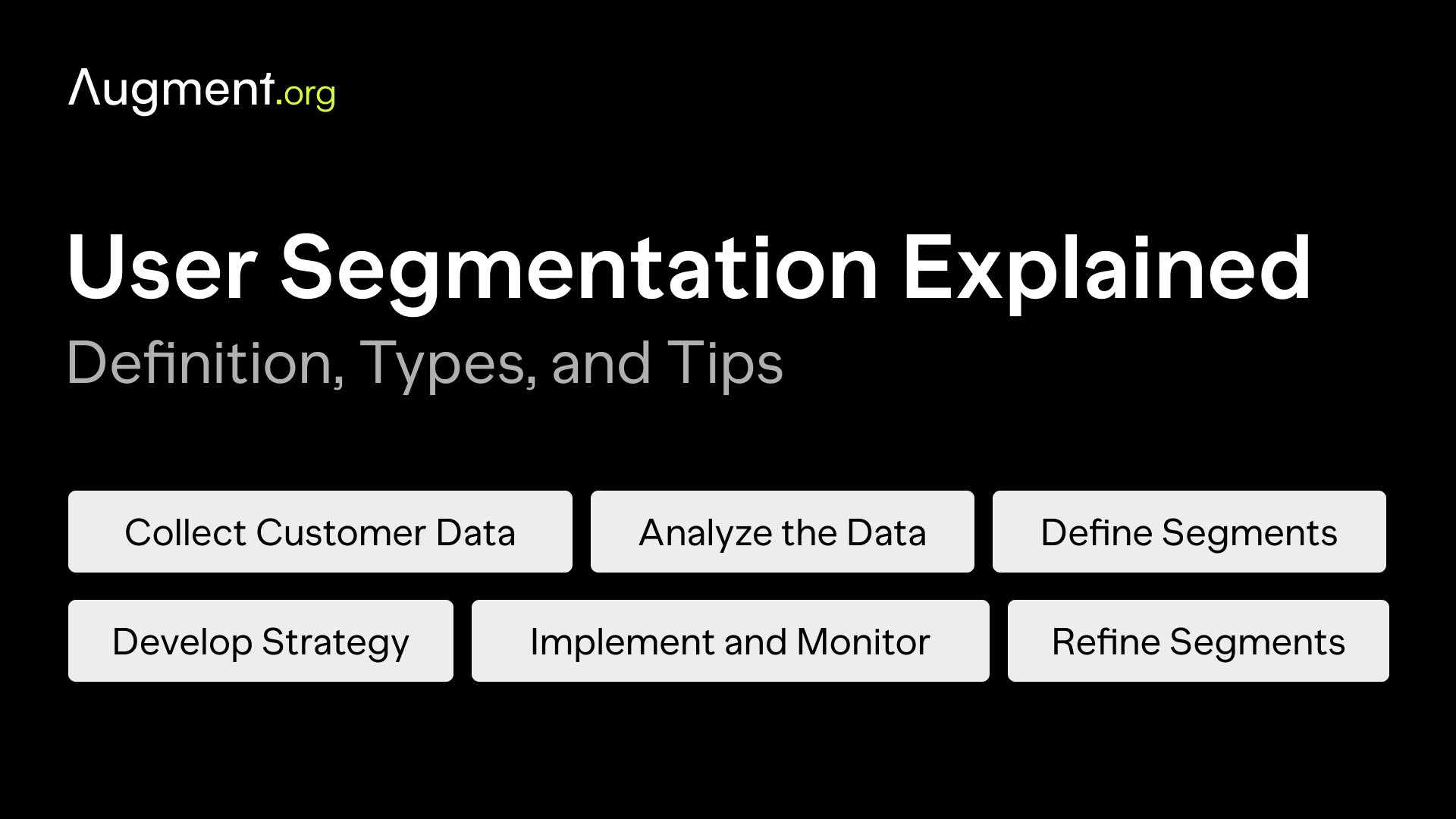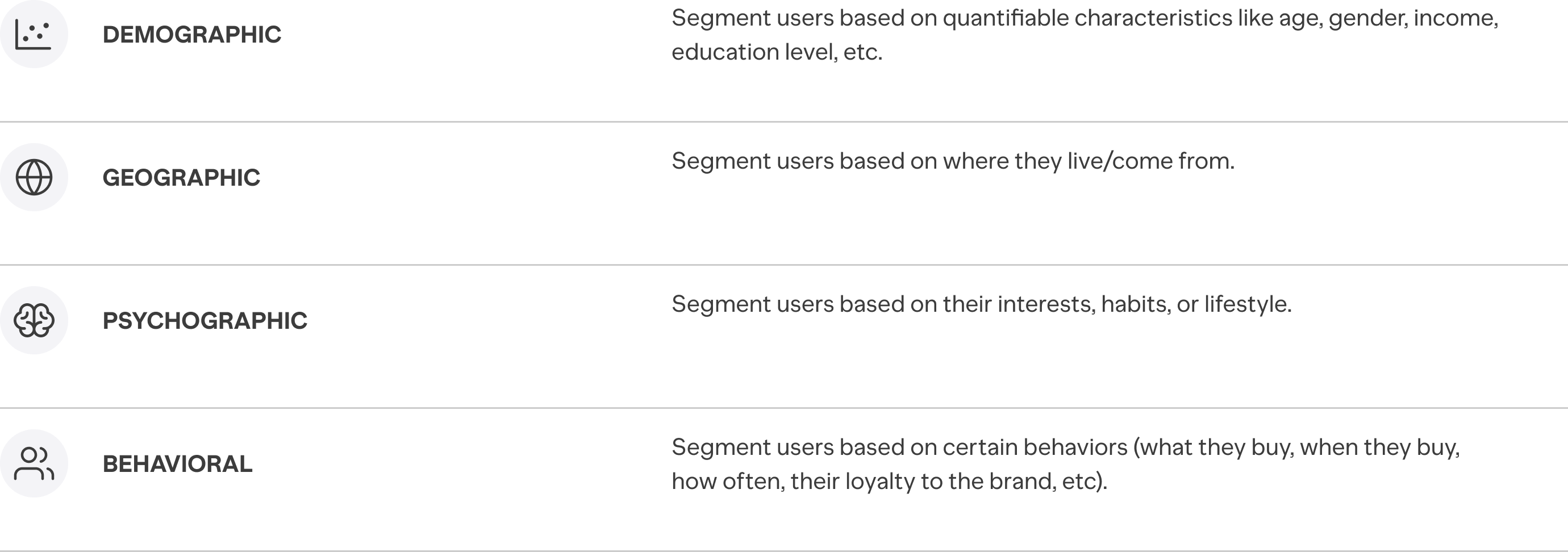User Segmentation Explained: Definition, Types, and Tips
User segmentation helps businesses tap into the diverse needs and behaviors of their user base. By segmenting users based on key characteristics, companies can tailor their marketing strategy and product offerings to better meet customer needs and boost customer loyalty.

What is User Segmentation?
User segmentation is the process of dividing a user base into distinct groups, or segments, based on shared characteristics. This strategy enables businesses to address the unique needs and preferences of different user segments more effectively. By analyzing customer data, companies can identify patterns in user behavior, preferences, and engagement levels.

The customer segmentation process often involves categorizing users based on various factors, such as demographics (age, gender, occupation), psychographic attributes (interests, values), and behavioral patterns (purchase history, product usage). This approach allows businesses to create more targeted marketing strategies and develop products and services that resonate with specific customer segments.
Essentially, the customer segmentation model is a foundational element of a tailored customer journey. It enables businesses to send the right message to the right people at the right time, fostering a deeper connection with their audience. Whether it’s engaging new customers, nurturing existing ones, or re-engaging inactive users, user segmentation forms the backbone of a customer-centric business model.
Why is User Segmentation Important?
User segmentation is crucial in today’s business landscape because it allows companies to understand and meet the diverse needs of their customer base more effectively. By segmenting users, businesses can create targeted marketing strategies that resonate with specific groups, enhancing the overall customer journey and boosting customer satisfaction.
- Enhanced Personalization: User segmentation enables businesses to personalize their offerings and communications. Tailoring messages and products to suit the specific needs of different segments leads to higher engagement and loyalty among customers.
- Improved Product Development: Understanding the distinct needs of various user segments can guide product teams in developing features and services that address these specific requirements. This targeted approach to product development ensures that new features are relevant and valuable to the users they're designed for.
- Efficient Marketing: Segmenting users allows marketing teams to allocate resources more efficiently. By identifying key customer segments, businesses can focus their marketing efforts on the most profitable or promising groups, maximizing return on investment.
- Enhanced Customer Insights: The process of user segmentation involves collecting and analyzing customer data. This analysis provides deeper insights into customer behaviors and preferences, which can inform all areas of business strategy.
- Increased Customer Retention: By meeting the specific needs of different customer segments, businesses can increase customer satisfaction and loyalty, leading to higher retention rates. Satisfied customers are more likely to become repeat buyers and recommend the business to others.
- Competitive Advantage: In a crowded market, businesses that effectively segment their users can gain a competitive edge. By understanding and catering to the unique needs of their segments, companies can differentiate themselves from competitors who may take a more generalized approach.
What are Common Types of User Segments?
In user segmentation, various common types of user segments are identified based on shared characteristics. These segments allow businesses to target specific groups with tailored strategies. Here are some of the most common types:
- Demographic Segmentation: This involves grouping users based on demographic factors such as age, gender, income, education, and occupation. It's a straightforward approach, often used because demographic data is relatively easy to obtain and can be highly indicative of user preferences and needs.
- Geographic Segmentation: Users are segmented based on their location – city, region, country, or climate zone. This type is crucial for businesses whose products or services vary in relevance and popularity across different geographical areas.
- Psychographic Segmentation: This segmentation focuses on the psychological aspects of consumer behavior, including values, attitudes, interests, and lifestyles. It helps in understanding the motivations behind user choices and tailoring marketing strategies to resonate with these motivations.
- Behavioral Segmentation: Users are grouped according to their behavior patterns, like usage rate, brand loyalty, and purchase history. This type is essential for businesses looking to target users based on their interactions with products or services, such as frequent users, trial users, or occasional users.
- Customer Journey Segmentation: Here, segmentation is based on the different stages of the customer journey. This approach helps in customizing marketing strategies for each stage - from awareness and consideration to purchase and loyalty.
- Needs-Based Segmentation: This type involves segmenting users based on their specific needs and preferences. Businesses use this to tailor their offerings to address particular problems or desires of distinct user groups.
- Value-Based Segmentation: It groups users based on the value they bring to the business. This can include segmentation into categories like high-spending power users, regular customers, and low-engagement users.
6 Steps to User Segmentation
Segmenting users effectively is a key step in tailoring marketing strategies and improving customer engagement. Here’s a guide on how to segment customers:
1. Collect Customer Data
- Objective: The first step is to gather comprehensive information about your customer base. This foundational step is crucial for starting with user segmentation.
- Data Collection: Employ various methods to accumulate data, including surveys, feedback forms, website analytics, and purchasing records. Focus on demographic, psychographic, and behavioral data.
- Considerations: Ensure to collect data that covers multiple users, reflecting the diversity in your existing customer base. The data should encompass information about individual users' preferences, behaviors, and interactions with your brand.
2. Analyze the Data
- Objective: Transform raw data into meaningful insights. This step in the segmentation model helps in understanding how users interact with your products or services.
- Methods: Use statistical tools and analytics software to segment data. Look for patterns and trends that reveal different user behaviors, preferences, and needs.
- Analysis Depth: Go beyond surface-level observations. For example, in behavioral segmentation, don't just look at purchase frequency but also consider the motivations behind these purchases and how different groups based on behavior might need different approaches.
3. Define Segments
- Objective: Based on the customer segmentation analysis, create user segments. This is the crux of the segmentation process, where you define different segments within your customer base.
- Criteria: Segments can be formed based on various criteria like demographics, behavior, or user flow through your product. It's crucial to identify which criteria are most relevant for your business and customer base.
- Refinement: Ensure that the segments are distinct and meaningful. For example, when segmenting customers based on behavior, distinguish between loyal customers and those who are still in the onboarding process.
4. Develop Segmentation Strategy
- Objective: Create a tailored approach for each segment. This involves devising a customer segmentation strategy that addresses the specific needs and preferences of each group.
- Implementation: Consider different marketing, product, and service strategies for each segment. For instance, for a segment of tech-savvy users, digital marketing might be more effective, while traditional marketing could be better for another segment.
- Collaboration: Work with product teams and marketing departments to ensure strategies are aligned with the overall business goals and customer experience.
5. Implement and Monitor
- Objective: Put your segmentation strategy into action and keep an eye on its performance.
- Implementation: Apply your strategies across various channels. This could involve personalizing marketing messages, customizing the user experience, or tailoring the product offering.
- Monitoring: Use key performance indicators (KPIs) to track the effectiveness of your segmentation. Adjust strategies based on real-time feedback and performance data.
6. Refine Segments Over Time
- Objective: Keep your segments and strategies relevant and effective as your business and customer base evolve.
- Continuous Learning: Regularly collect and analyze new data to understand how your segments are changing or if new segments are emerging.
- Adaptability: Be prepared to modify your segmentation model and strategies. For example, if new trends emerge among current customers, it may be necessary to create new segments or adjust existing ones.
Remember, the goal of this user segmentation strategy is to understand and cater to the specific needs of different groups within your user base, enhancing their overall experience and your business performance.
Book a call with our Program Director
Book a 15-minute call with our Program Director to discuss your goals and what the Augment MBA has to offer.
Book a callUser Segmentation Example
To illustrate how user segmentation can be effectively applied, let's consider a hypothetical example involving an online retail store.
- Scenario: The store offers a wide range of products, catering to a diverse customer base. To optimize their marketing strategy and improve customer experience, the store decides to implement user segmentation.
- Step 1: Collecting Data The store begins by gathering data on its customers. This includes information from sales records, customer accounts, and interactions on their website. They pay special attention to purchase history, product preferences, frequency of purchases, and customer feedback.
- Step 2: Analyzing Data Using a product analytics tool, the store analyzes the collected data. They discover patterns in purchasing behavior, product preferences, and engagement with marketing campaigns.
- Step 3: Creating User Segments Based on the analysis, the store
- identifies several key user segments:
- Paid Users: Customers who frequently make purchases and are subscribed to the store's premium service.
- Free Users: Visitors who browse the site but have not made a purchase or only occasionally buy items.
- Active Users: Customers who regularly interact with the store through purchases, reviews, and participation in loyalty programs.
- Segment by Product Preference: Customers who show a strong preference for certain categories of products, such as electronics or clothing.
- Step 4: Tailoring Strategies for Each Segment The store then develops tailored strategies for each segment:
- Paid Users: They are offered exclusive deals and early access to new products to encourage continued loyalty.
- Free Users: Targeted with special first-time buyer discounts and informative content about the products to encourage purchases.
- Active Users: Engaged with personalized recommendations and rewards for their frequent interactions.
- Product Preference Segments: Receive targeted marketing for new arrivals and promotions in their preferred categories.
- Step 5: Monitoring and Refining The store continuously monitors the effectiveness of these strategies using key performance indicators like conversion rates, customer satisfaction scores, and repeat purchase rates. They refine their segments and strategies over time to adapt to changing customer behaviors and market trends.
Outcome: By implementing user segmentation, the store is able to provide more relevant and personalized experiences to different groups of customers. This results in higher customer satisfaction, increased sales, and enhanced customer loyalty.



